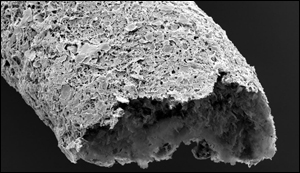Biomaterial discovery enables 3D printing of tissue-like vascular structures
4. 3. 2020 | University of Nottingham | www.nottingham.ac.uk
An international team of scientists have discovered a new material that can be 3D printed to create tissue-like vascular structures. New study was published in Nature Communications.
Self-assembly is the process by which multiple components can organise into larger well-defined structures. Biological systems rely on this process to controllably assemble molecular building-blocks into complex and functional materials exhibiting remarkable properties such as the capacity to grow, replicate, and perform robust functions.

The new biomaterial is made by the self-assembly of a protein with graphene oxide. The mechanism of assembly enables the flexible (disordered) regions of the protein to order and conform to the graphene oxide, generating a strong interaction between them. By controlling the way in which the two components are mixed, it is possible to guide their assembly at multiple size scales in the presence of cells and into complex robust structures. The material can then be used as a 3D printing bioink to print structures with intricate geometries and resolutions down to 10 mm.
Read more at University of Nottingham
Image Credit: University of Nottingham
-jk-




